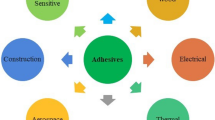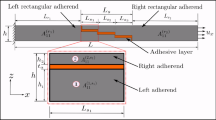Abstract
Besides the determination of the force and the energy needed to break individual fibre to fibre joints, the investigation of the formerly bonded area (FBA) is of essential importance to learn more about the failure mechanisms of fibre–fibre bonds in general. In this study the surfaces of paper fibres and the FBA of fibre–fibre joints after the determination of the breaking force as well as the bonding energy were analysed by means of low voltage scanning electron microscopy and atomic force microscopy. A comparison between the contact zone of fibres broken at different loading rates as well as under cyclic loading showed that there seems to be no significant difference in the appearance of the FBA in these cases. Only minor delamination of the cell wall could be found in the bonding zone, which indicates no mechanical interlocking of fibrils in the bonding zone. Furthermore, it is shown that some glues used for specimen preparation of fibre–fibre bond strength measurement are forming a glue film on the fiber surface and migrate into the bonding region.









Similar content being viewed by others
References
Binnig G, Quate C, Gerber C (1986) Atomic force microscope. Phys Rev Lett 56(9):930–933
Fischer WJ, Hirn U, Bauer W, Schennach R (2012) Testing of individual fiber–fiber joints under biaxial load and simulataneous analysis of deformation. Nord Pulp Pap Res J 27(2):237–244
Goldstein JI, Newbury DE, Echlin P, Joy DC, Lyman CE, Lifshin E, Sawyer L, Michael JR (2003) Scanning electron microscopy and X-ray microanalysis. 3rd edn. Kluwer/Plenum, Dordrecht
Jayme G, Hunger G (1961) Electron microscopy 2- and 3-dimensional classification of fibre bonding. In: Bolam F (ed) Formation and structure of paper—transaction of the IIth fundamental research symposium held at Oxford, pp 135–170
Joy DC, Joy CS (1996) Low voltage scanning electron microscopy. Micron 27(3–4):247–263
Kang T, Paulapuro H, Hiltunen E (2004) Fracture mechanism in interfibre bond failure—microscopic observations. Appita J 57(3):199–203
Kappel L, Hirn U, Bauer W, Schennach R (2009) A novel method for the determination of bonded area of individual fibre–fibre bonds. Nord Pulp Pap Res J 24(2):199–205
Li K, Lei X, Lu L, Camm C (2010) Surface characterization and surface modification of mechanical pulp fibres. Pulp Pap Can 111(1):T11–T16
Lindström T, Wågberg L, Larsson T (2005) On the nature of joint strength in paper—a review of dry and wet strength resins used in paper manufacturing. In: Advances in paper science and technology—transactions of the 13th fundamental research symposium held at Cambridge, pp 457–562
Mayhood CH, Kallmes OJ, Cauley MM (1962) The mechanical properties of paper part II. Measured shear strength of individual fiber to fiber contacts. Tappi J 45(1):69–73
Okamoto T, Meshitsuka G (2012) The nanostructure of kraft pulp 1: evaluation of various mild drying methods using field emission scanning electron microscopy. Cellulose 17(6):1171–1182
Page DH (1969) A theory for the tensile strength of paper. Tappi J 52(4):674–681
Persson BNJ, Ganser C, Schmied FJ, Teichert C, Schennach R, Gilli E, Hirn U (2013) Adhesion of cellulose fibers in paper. J Phys Condens Matter 25(4):045002
Reimer L (1993) Image formation in low-voltage scanning electron microscopy. SPIE-Press, Bellingham, Washington
Saketi P, Kallio P (2011) Measuring bond strength of individual paper fibers using microrobotics. In: Hirn U (ed) Progress in paper physics seminar 2011. Verlag der Technischen Universität Graz, Graz, pp 199–203
Schmied F, Teichert C, Kappel L, Hirn U, Schennach R, Schröttner H (2009) Comparative AFM and SEM investigations on kraft pulp fiber surfaces. In: Kothleitner G, Leisch M (eds) Instrumentation and methodology, pp 299–300
Schmied FJ, Teichert C, Kappel L, Hirn U, Bauer W, Schennach R (2013) What holds paper together: nanometre scale exploration of bonding between paper fibres. Sci Rep 3:1–6. doi:10.1038/srep02432
Schmied FJ, Teichert C, Kappel L, Hirn U, Schennach R (2012) Analysis of precipitated lignin on kraft pulp fibers using atomic force microscopy. Cellulose 19(3):1013–1021
Stokes DJ (2008) Principles and practice of variable pressure/environmental scanning electron microscopy (VP-ESEM). Wiley, New York
Stratton RA, Colson NL (1990) Dependence of fiber/fiber bonding on some papermaking variables. Technical Report IPST Technical Paper Series. Number 357, Institute of Paper Science and Technology Atlanta, Georgia
Zankel A, Kraus B, Poelt P, Schaffer M, Ingolic E (2009) Ultramicrotomy in the ESEM, a versatile method for materials and life sciences. J Microsc 233(1):140–148
Acknowledgments
The Authors want to thank Mondi, the Austrian Federal Ministry of Economy, Family and Youth and the National Foundation for Research, Technology and Development.
Author information
Authors and Affiliations
Corresponding author
Rights and permissions
About this article
Cite this article
Fischer, W.J., Zankel, A., Ganser, C. et al. Imaging of the formerly bonded area of individual fibre to fibre joints with SEM and AFM. Cellulose 21, 251–260 (2014). https://doi.org/10.1007/s10570-013-0107-0
Received:
Accepted:
Published:
Issue Date:
DOI: https://doi.org/10.1007/s10570-013-0107-0




